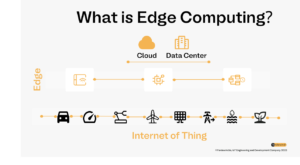The Rise of Edge Computing

The Internet of Things has transformed the way we think about computing and data processing. IoT devices generate enormous amounts of data, and traditional cloud-based computing systems have struggled to keep up. However, with the rise of edge computing, this is changing.
Edge computing is a decentralized computing paradigm that brings computing power and data storage closer to the source of the data. In this article, we will explore the rise of edge computing and how it is shifting the IoT industry towards decentralized computing.
So, what is Edge Computing?

Edge computing refers to a computing paradigm where data is processed and analyzed at or near the source of the data, rather than being sent to a centralized data center or cloud computing system. This approach is particularly useful for IoT devices, which generate vast amounts of data that can be difficult to process and transmit.
Edge computing involves the use of small, low-power computing devices that are deployed closer to the source of the data. These devices are capable of processing data in real-time, enabling faster decision-making and reducing latency
Additionally, IoT devices generate massive amounts of data, and traditional cloud computing systems can struggle to handle the volume and velocity of this data. Edge computing provides a solution to this problem by enabling data processing and analysis to be done at or near the source of the data.
By processing data at the edge of the network, IoT devices can operate in real-time, without the latency that can be introduced by sending data to a centralized cloud computing system. This is particularly important for applications where real-time decision-making is critical, such as in autonomous vehicles or industrial automation.
Edge computing also has the potential to reduce the amount of data that needs to be transmitted to the cloud. By processing and analyzing data at the edge, only relevant data needs to be transmitted to the cloud, reducing the amount of bandwidth required and minimizing the risk of data breaches or cyber-attacks.
The Benefits of Edge Computing for IoT
Beside this, edge computing offers a number of benefits for IoT applications, including:
- Real-time Processing: By processing data at the edge of the network, IoT devices can operate in real-time, without the latency introduced by sending data to a centralized cloud computing system.
- Improved Efficiency: Edge computing can reduce the amount of data that needs to be transmitted to the cloud, reducing the bandwidth required and minimizing the risk of data breaches or cyber-attacks.
- Improved Security: By processing data at the network’s edge, sensitive data can be kept closer to the source, reducing the risk of data breaches or cyber-attacks.
- Reduced Cost: Edge computing can reduce the cost of transmitting data to the cloud, as only relevant data needs to be transmitted.
Furthermore, the future of edge computing for IoT looks bright. As IoT devices continue to proliferate, the need for real-time processing and analysis of data will only increase. Edge computing provides a solution to this problem, enabling IoT devices to operate more efficiently and securely.
Some of the key developments to look out for in the future of edge computing for IoT include:
-Increased Adoption: Edge computing is becoming increasingly popular in the IoT industry, and we can expect to see more devices and applications using this technology in the future.
-Improved Hardware: The development of more powerful and efficient edge computing hardware will continue to drive the adoption of this technology in the IoT industry.
-Artificial Intelligence and Machine Learning: Edge computing provides a platform for deploying AI and machine learning algorithms, enabling IoT devices to become even more intelligent and autonomous.
Finally, edge computing is a game-changer for the IoT industry, enabling real-time processing and analysis of data at or near the data source. With improved efficiency, security, and cost-effectiveness, edge computing provides a compelling solution to the challenges of processing and analyzing data generated by IoT devices.
Fordewind.io is an IoT engineering and development company based in Kyiv, Ukraine. Our main areas of interest and expertise are the automotive industry and Smart Home/City projects. Contact us right now without a doubt and learn more about how we can help you build the future.